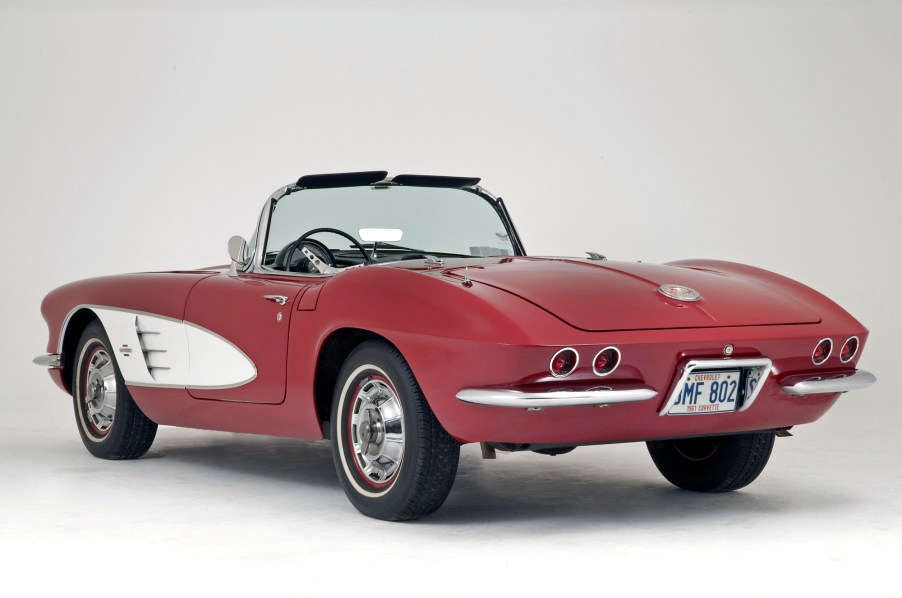
Chevrolet Corvette: Decades of Mid-life Crises and Astronauts
The Chevrolet Corvette has evolved from an American sweetheart sports car to a full-fledged supercar. However, it took nearly 70 years for the Corvette to become the mid-engine monster that Zora Arkus-Duntov always imagined. The American icon also had quite a story along the way, from the C1 to the C6, C7, and C8 generations. Here’s a brief history of America’s (and the Astronauts’) sports car, the Chevrolet Corvette.
When did Chevrolet first start making Corvettes?
The first Chevrolet Corvette, the C1, was first sold in 1953. However, it wasn’t a V8-powered rocket like later models. Instead, it was powered by a 150-horsepower Blue Flame inline-six engine. However, in 1955, Chevrolet stuffed a 195-horsepower 265-cubic inch V8 into the fiberglass sports car. The handsome little first-generation Corvette drove on until 1962 when shoppers could outfit it with a range-topping 360-horsepower 327-cubic inch V8.

C2 through C3: a car fit for Astronauts
The C2 kicked off with the iconic Sting Ray body style and its famous split bumper and pop-up headlight combination. The C2 generation car also carried over V8 power and introduced the beloved Z06. One of the most remarkable tidbits in C2 and C3 Corvette history is the relationship between the sports car and NASA’s Astronauts of the time. A local dealership, to sidestep the Government’s rules on gifts for employees, offered Corvettes to Astronauts on a $1 lease.
The offer was so popular that Astronauts like Alan Shepard, Buzz Aldrin, Gordon Cooper, Gus Grissom, and the immortal Neil Armstrong drove Chevrolet Corvettes. This phenomenon continued into the third generation Corvette, the C3, which began with the 1968 car. The C3’s long, sharkish lines were almost as expansive as its tenure. The third generation Corvette ran until 1982, through the oil crisis and the addition of fuel injection.
C4 and C5: let’s dial it up a bit
The C4 Corvette started life in 1984 with a wedge shape and sharp lines like never before. 1989 and 1990 saw the reintroduction of the ZR1, a top-tier performance moniker that Chevrolet introduced on the 1970 C3 car. According to Car and Driver, the C4 gave way to the C5 in 1996, but not before introducing the Grand Sport.

The C5, which took to the streets in 1997, introduced the LS engine to the lineup. The lighter, sharper fifth-generation Chevrolet Corvette continued until 2005, but not before bringing the Z06 back with a volcanic 405 horsepower.
The C6 and C7 Corvette brought the sports car up to world-class standards
The sixth-generation car ditched the hideaway headlights that Corvette had used since the C2. However, the new vehicle packed a 6.0L LS2 engine, upping the power to 400. The news improved with the 2006 C6 Z06, which introduced the 505-horsepower LS7 V8. The C6 conquered roads until 2014 when Chevrolet introduced the C7 Corvette.

The venerable C7 Corvette capitalized on the successes of the C6 by introducing a 455-horsepower LT1 V8. According to MotorTrend, the C7 Z51 would hit sixty in just 3.8 seconds, and with natural aspiration. Both the C6 and C7 had Grand Sport and Z06 variations. Of course, the king of the hill was the 2019 ZR1, a 755-horsepower swan song for the front-engined Corvette.
C8 and the future: the Chevrolet Corvette seems unstoppable
In 2020, the Chevrolet Corvette went mid-engine. Beyond the controversial new design, the platform will allow the C8 Z51, 670-horsepower flat-plane Z06, and eventual ZR1 to punch way above its weight class. Love it or hate it, future iterations of the Corvette seem to be headed for electrification and all-wheel drive (AWD). Wherever the Chevrolet Corvette runs from here, it’s sure to take fans with it.
Scroll down to the following article to read more about the Corvette and sports cars!



